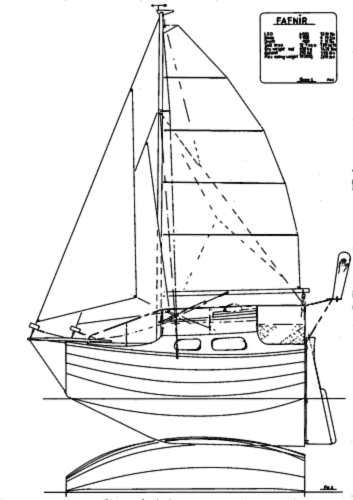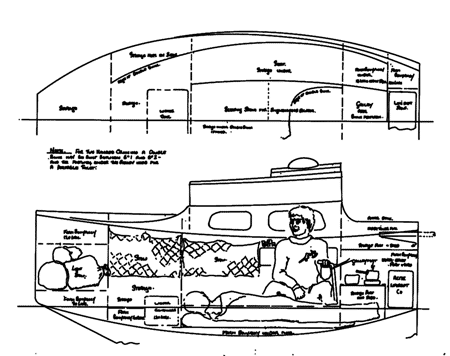| “The sunburned skipper looked out over the stubby bowsprit at the long shadow under the streamer of tropical cloud. It had been a good trip, surging along in the trades and the routine of keeping ship, navigating and reading his library of second hand paperbacks had kept him happily occupied in his own self contained world. While there was triumph and anticipation in the landfall, there would be fresh stores, more books, a new CD or two of music, and some welcome times with good sailing friends as yet not met, the intrusion of the outside world would be a loss as well. He was looking forward to being anchored off a white sand beach, watching the palms nodding in the warm wind, planning and preparing for the next leg of the voyage, it would not be long before the blunt little bow poked out through the pass in the reef and turned downwind for the next long leg of his voyage.” |
FAFNIR
A tough little cruiser for one or two
Length on deck |
13ft 1in |
4 metres |
Beam |
6ft 2in |
1.90 m |
Draft |
2ft 7in |
0.800 m |
Sail Area |
139 sq ft |
14.9 Sq m |
Dry weight est. |
1430 lbs |
650 kg |
Ballast |
550 lbs |
250 kg |
Max. Sailing Weight |
2420 lbs |
1100 kg |
|
Fafnir is descended from Gimli, a study drawing intended to give an idea what would be required for a race around the world in boats only 10ft (3.048m) long. That race was to be held on a course where the longest single leg was only about 1800 tradewinds miles, and where support would be available at every port. A race like that is a big deal for such a small craft, and Gimli had a canting keel, daggerboards for lateral plane and balance, a fully battened carbon fibre rig and every trick I could think of to make her competitive as well as seaworthy.
The study drawing was put up on the Around in 10 yahoo group's front page along with one from Matt Layden, and there was a lot of interest expressed. To date no one wanted to go with the original concept. But! It sparked an idea for a very much longer voyage in one gentleman’s mind, and after considerable discussion on provisioning and route planning we settled on 4m long as the limit, a fixed medium draft keel, a simpler rig and plywood rather than foam and fibreglass as the construction medium.

I had to go and find another name, the dwarf warrior being the theme I looked into Norse mythology and found Fafnir. The son of a dwarf king facing real problems with a dragon, he sent two sons out to deal with the intractable lizard, and after seeing his brother toasted Fafnir, brave, indomitable and resourceful, went into battle and turned the dragon’s lights out. Fafnir, a very short but burly and resourceful warrior, a good man to have on your side! I figure that if you are going voyaging in a very small boat, those characteristics will be reassuring on a dark night when the wind howls in the rigging.
Fafnir is much bigger than you’d expect in a boat of this length, I’ve a rowing boats a lot longer and can pick it up and carry it singlehanded. But this one is broad, deep, very strong, and able to carry her crew and enough stores for a couple of months in reasonable comfort. That gives a range in reasonably favourable winds of about 3000 miles. As with any small boat, in the open sea one would not expect to make much progress to windward when the breeze pipes up, but seasonal winds are well documented, and it’s not beyond possibility that this little boat could make long passages safely.
On the safety issue, I’ve detailed foam buoyancy of approximately 500 kg in volume, this plus the buoyancy of the wood will keep her head above water if holed and give the option of repair and pumping her out, or collecting as much in the way of equipment as possible before sliding the liferaft over the side. One hopes that will never be needed, but its best to plan for the worst and hope for the best.
While the interior as designed is intended as a singlehander, the two side seats can be carried across the footwell and made into a big double bed which will be long and wide enough to sleep two on, so cruising as a couple is quite practical. I can visualise a young couple, exploring an interesting coastline 20 miles or so a day at a time as they explore life together and have adventures that will be part of the glue that maintains their relationship for the rest of their lives.

Comfort and variety of position is very important in small boats, and Fafnir has 7 good seating places, one is in the “bunk” which stretches fore and aft along the centreline between the seat fronts giving a 2.2m long by 800mm wide flat space with the seats forming side boards that will keep the skipper in his bed when the boats being bounced around. There is space to sit up here and relax partly stretched out. The next two are the side seats amidships, there is room to lean back with feet braced against the seat on the opposite side and read, steer with the internal tiller or cook a meal in the little galley under the after deck. On good days the companionway steps are a good place for sitting at low level with the head just clear of the hatch opening, or higher up in the hatch opening legs inside, and on really nice days you can sit yourself on either side of the little after deck with space enough to sprawl out and sunbathe.
The deck is designed to offer working space on the after or foredecks, and the cabin top is made of flat panels rather than a cambered arc so that it is easier to clamber along when going forward. (It’s easier to build as well!) That latter is not needed very often as the sails can be handled completely from the hatchway. Roller furling on both jib and staysail means they can be put away or pulled out easily and the main has three slab reefs all of which can be accessed and actioned without going on deck.
Long keels are considered to be the right thing to have for long range cruisers, and in this case I had originally considered a much deeper fin with a lead bulb on the end, but after discussion conceded that a shallower wood framed full length keel with lead ballast inside would improve the steering, protect the rudder and allow the boat to creep up creeks and into protected and unoccupied corners of anchorages when exploring. It contributes a huge amount of strength to the hull as well! That plus you don’t need to melt ¼ of a ton of lead and cast a complex shaped bulb in your kitchen, just make small ingots a few pounds at a time.
One of the major issues with the dream of building an ocean going cruiser is “where?” In this case my original customer needed to be able to build within the confines of a single car garage, and Fafnir is about as much as you can get in there and still get around the sides and ends.
Built from plywood on stringers, with plywood frames holding her in shape as well as mounting all the interior furniture this is an easy build, in fact it might just be the easiest blue water cruiser to build that I’ve seen. There is very little twist in the planking, just simple bends, and the cabin has few complexities with even the hatch being glued up from three layers of thin ply glued over a jig. The tools required to build Fafnir are not going to break the bank. I’d buy a good hand held jigsaw, a good random orbital sander and a cordless drill which will be used as a screwdriver. That plus a few hand tools will do the job, and ordinary handyman skills with some patience and a willingness to learn will see a new boat ready to sail in pretty short order.
John Welsford
Designer
Plans for Fafnir are avable from
Duckworks Boat Builder's Supply |

